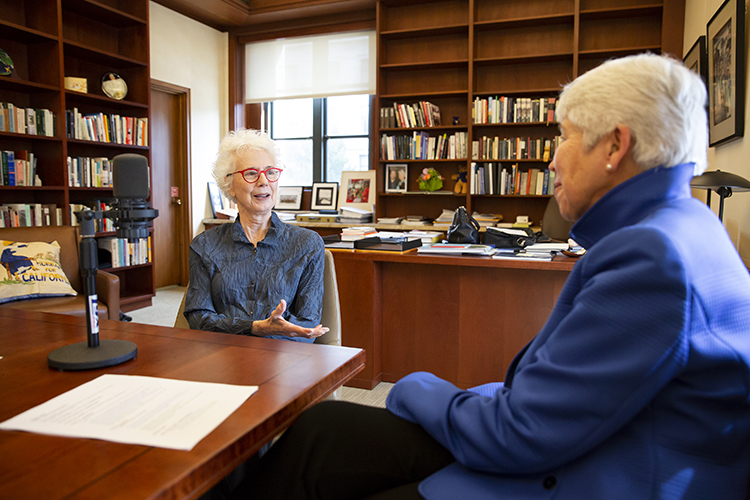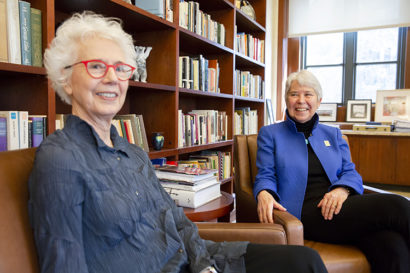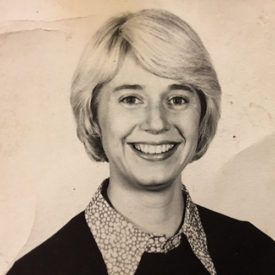
When Clover and Christ both began in academia in the early 1970s — Clover at Harvard and Christ at Berkeley — people often didn’t believe they were faculty members. “People always thought that I was a secretary in my office,” says Clover. “They would just walk in and say, ‘Would you please type this for me and have it for tomorrow?'” (UC Berkeley photo by Brittany Hosea-Small)
Carol Christ: At the Faculty Club at Berkeley, women were not allowed. I think it was either 1970 or 1971 when women were allowed in the Faculty Club. There were photographs I’ve seen from the 1960s in which meetings are taking place inside the Faculty Club, and women are sitting on the window sills with their feet outside, leaning in through the windows to hear the meeting.
Carol Clover: Oh, my. That’s great.
Carol Christ: So that’s why there’s a Women’s Faculty Club at Berkeley. Women were not allowed in the Faculty Club. It always shocks me that it was that late that the Faculty Club became coed.

Christ says it wasn’t until she came back to UC Berkeley in January 2015 after serving as president at Smith College from 2002 to 2013 that she realized how “male-inflected” the culture at Berkeley still was. (UC Berkeley photo by Brittany Hosea-Small)
Anne Brice: Did you have a sense that it was certainly unfair? Or was it also a sense of, this is how things are? How did you feel at that time?
Carol Clover: Well, it took a while to register that there were no women. I’m not sure that I thought of it as natural, but it took me a while for it to sink in. Especially when I was getting my Ph.D. At that moment, I realized it was rare. It was odd.
Carol Christ: That’s a really interesting question. I mean, because I did my graduate work at Yale, I was so used to feeling marginal in a very privileged, wealthy, male environment that when I came to Berkeley, it felt so liberating to me. The whole culture felt so liberating that I think I wasn’t as attentive then as I would be now to the way in which there was a kind of stratified sexism.
The undergraduate student body, the graduate student body, had a very good balance. There wasn’t a sense that men and women were treated differently. But in the faculty, there were very few women. I always felt like a pioneer, in part, because I’m of the generation of the feminist revolution.
So, paradoxically — this is a little bit embarrassing to say — it wasn’t until I came back to Berkeley from being at Smith for 11 years that I realized how male-inflected the culture still was.

Carol Clover in 1976 during her time at Harvard as an assistant professor. She came back to teach at Berkeley in the late 1970s, where she became a professor in the Department of Scandinavian Languages and Literatures and the Department of Rhetoric. (Photo courtesy of Carol Clover)
Carol Clover: Harvard is like Yale. It’s a very male place, as suggested by my Faculty Club story. Berkeley is so much larger than Harvard and Yale. It’s so much more varied and it’s kind of culturally richer in some sense. It felt better to me.
And by the time I got back in the late 70s, things had changed. Things were very much changing — this was in the 80s, with women’s movements. To have the Women’s Studies Program, to have courses on women’s issues and to have the women’s center. And to start the Beatrice Bain Research Group — we created that and named it. We got funding for it, and we had a funky little building on campus to bring scholars here. It took a lot of time to create those things. It took a lot of work and kind of institutional juggling to make it happen.
Carol Christ: Yeah. We were both involved in the creation of women’s studies. I remember when I first got interested in the curricula that concerned women’s issues, there was an organization called the Feminist Press that published syllabi of courses that had a feminist focus. They came in a plain brown paper envelope. And I remember the first of these was 50 courses across the country.
So it was a revolution in our time that we both participated in that began as something new and revolutionary is now just part of the texture of the social sciences and humanities. I can’t imagine a department that doesn’t see questions about gender as absolutely fundamental to the discipline. But they were unusual, revolutionary in the late 60s and early 70s.
More Articles
- National Institutes of Health: For Healthy Adults, Taking Multivitamins Daily is Not Associated With a Lower Risk of Death
- National Archives Records Lay Foundation for Killers of the Flower Moon: The Osage Murders and the Birth of the FBI
- Nichola D. Gutgold - The Most Private Roosevelt Makes a Significant Public Contribution: Ethel Carow Roosevelt Derby
- Women's Health and Aging Studies Available Online; Inform Yourself and Others Concerned About Your Health
- Oppenheimer: July 28 UC Berkeley Panel Discussion Focuses On The Man Behind The Movie
- Sheila Pepe, Textile Artist: My Neighbor’s Garden .... In Madison Square Park, NYC
- "Henry Ford Innovation Nation", a Favorite Television Show
- Julia Sneden Wrote: Going Forth On the Fourth After Strict Blackout Conditions and Requisitioned Gunpowder Had Been the Law
- National Institutes of Health: COVID-19 Vaccines Linked to Small Increase in Menstrual Cycle Length
- Ask KHN (Kaiser Health News) - PolitiFact: Is My Cloth Mask Good Enough? The 2022 Edition






